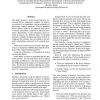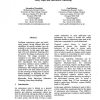496 search results - page 30 / 100 » Using the Temporal Logic RDL for Design Specifications |
RANLP
2003
14 years 11 months ago
2003
This paper reports a research effort in scenario recognition task in information extraction. The presented approach uses partial semantic analysis based on logical form representa...
ACL
2004
14 years 11 months ago
2004
This paper presents a multi-layered Question Answering (Q.A.) architecture suitable for enhancing current Q.A. capabilities with the possibility of processing complex questions. T...
DATE
2009
IEEE
15 years 4 months ago
2009
IEEE
This paper uses under-approximation of unreachable states of a design to derive incomplete specification of combinational logic. The resulting incompletely-specified functions are...
101
click to vote
UML
2001
Springer
15 years 2 months ago
2001
Springer
: There are many different ways to specify the requirements of complex software systems, and the optimal methods often vary according to the problem domain. We apply and compare tw...
EUSFLAT
2001
14 years 11 months ago
2001
Intelligent autonomous robots and multiagent systems, having different skills and capabilities for specific subtasks, have the potential to solve problems more efficiently and eff...


